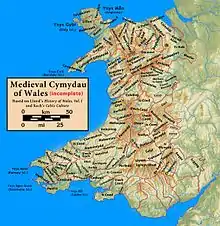Ystrad Marchell
Ystrad Marchell sometimes Strad Marchell[1] (English: Vale of Marchell[2][3]) was a medieval commote (cwmwd) in the cantref of Ystlyg in the Kingdom of Powys.[4] It roughly coincides with the parish of Welshpool.


It lay at the east of the kingdom, bordering the cantref of Caereinion to the west and south, and the cantref of Mechain to the north-west.[5] Within Ystlyg the other commotes were Deuddwr to the north,[6] Llannerch Hudol to the south and Y Gorddwr (or Corddwr[7]) to the east.[1] The cantref of Ystlyg (excluding Y Gorddwr) corresponds to the later hundred of Deuddwr.[6]
Ystrad Marchell was founded by or named for Marchell, a sister of the fifth or sixth century saint Tyfrydog.[8] She was also a saint and is associated with Capel Marchell near Llanrwst, and Ffynnon Farchell (English: Well of St Marcella) and St Marcella's Parish Church (formerly Llanfarchell) in Eglwys Wen near Denbigh.[9]
The valley of Ystrad Marchell is the site of the medieval Cistercian monastery of Strata Marcella (Latinised form of Ystrad Marchell, strata meaning paved road or causeway) which was founded in 1170-72 by Owain Cyfeiliog, who ruled the southern part (which would later be known as Powys Wenwynwyn) of the divided Kingdom of Powys, after the death in 1160 of Madog ap Maredudd, the last prince of the whole of Powys.
Together with Llannerch Hudol and Deuddwr it formed the Teirswydd ("three commotes") which were among the lands restored into the possession of Gruffydd ap Gwenwynwyn in return for his homage and fealty by Llywelyn ap Gruffudd at Ystumanner in 1263.[10]
References
- Rees, William (1951). An Historical Atlas of Wales from Early to Modern Times. Faber & Faber.
- Baring-Gould, Sabine; Fisher, John (1911). The Lives of the British Saints, Volume 3. London: The Honourable Society of the Cymmrodorion. p. 438. Retrieved 21 April 2015.
- Jones, John (1824). The History of Wales. London: J Williams. p. 105.
- Cathrall, William (1828). The History of North Wales Volume II. J Gleave and Sons. p. 353.
- "Cantrefs". Celtic Christianity.
- Carlisle, Nicholas (1811). A topographical dictionary of the Dominion of Wales (see Llandrinio). London: Society of Antiquaries.
- Carlisle, Nicholas (1811). A topographical dictionary of the Dominion of Wales (see Garth). London: Society of Antiquaries.
- Rees, Rice (1836). An essay on the Welsh saints or the primitive Christians, usually considered to have been the founders of the churches in Wales. Longman. p. 276.
- Baring-Gould, Sabine; Fisher, John (1911). The Lives of the British Saints, Volume 3. London: The Honourable Society of the Cymmrodorion. p. 437. Retrieved 21 April 2015.
- Smith, J Beverley (2014). Llywelyn ap Gruffudd: Prince of Wales. University of Wales Press.